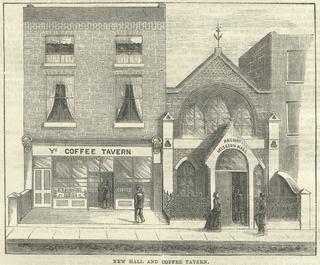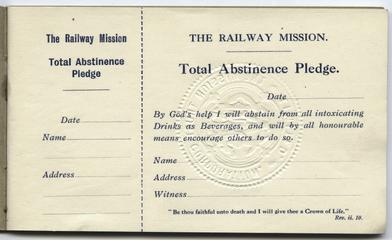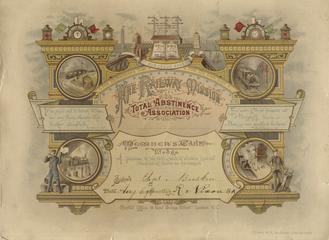
Railway Mission
The Railway Mission was founded on November the 14th 1881 at the Garden House Conference Hall, Mildmay Park, London when it merged with the Railway Boys Mission. Until the foundation of the Railway Men’s Christian Association in 1884 the Railway Mission did not have a personal membership, membership was organised around local secretaries responsible for providing a location for meetings, usually in the form of a mission hall or mission room, and often on land or in premises on loan from railway companies.
By 1890 there were 6,000 members and approximately 250 local missions around the United Kingdom and the majority of railway communities had a Railway Mission Hall. In the late nineteenth/early twentieth century, as British companies carried out railway building projects abroad, the Railway Mission spread to countries such as South Africa, Australia, Chile and Japan (dates of foundation are currently unknown) and members were encouraged to work abroad to spread the word of the Gospel.
As stated in the first entry in the minute book for 1881, the main object of the Railway Mission was “the moral and spiritual advancement of railway employees of all ages.” From its beginning meetings were held throughout the country for railwaymen who were unable to attend Sunday worship. From 1882 The Railway Signal was published providing information about meetings, entertainment and a spiritual message.
Another early activity was as part of the temperance movement. To combat the threat of drink, which was of great concern within the railway industry, the Railway Mission established coffee houses near railway stations as alternatives to public houses, and published articles against drink in The Railway Signal.
In a committee meeting held on July 7th 1887 the objectives of the Railway Mission were set as:
“1. To preach the Gospel to the employees on all lines, by means of accredited evangelists holding special missions at large centres and the establishment of weekly meetings for Prayer, Bible Study, and evangelistic addresses
2. To help those who profess to be Christians to make known the gospel to their mates, by an upright life and personal testimony
3. To advocate the cause of Temperance and the moral and social wellbeing of all grades and to assist, in every way possible, the various Societies already existing on our Railways.”
In 1890 the Railway Mission opened its first convalescent home for railway men in Hastings, Sussex. This then moved to St Leonards-on-Sea in 1897 and a second home later opened in Southport.
During the First World War thousands of members of the Railway Mission enlisted in the military and pressure on the railways increased significantly. After the War, the railway system changed and the Railway Mission went into decline with many local branches and both convalescent homes closing and by 1921 only 150 branches remained. However, new branches also opened, such as the Spring Road branch in Birmingham in 1929.
The impact of the Second World War on the Railway Mission was similar, with only 83 branches remaining at its close. Some of the closed mission halls became independent churches and continue to operate until this day. Despite a decrease in membership the Railway Mission continued. In the 1960s an evangelist was employed full time by the Mission to work across the entire network, with others soon being employed for specific geographic regions. From 1985 these workers came to be known as Railway Mission chaplains. The reinvigoration of the Railway Mission coincided with a decrease in welfare provision by British Rail during the 1980s. In 1985 the chairman of British Rail, Sir Robert Reid, encouraged the five regional general managers to allow chaplains to have access to staff and provide them with practical assistance.
The Railway Mission currently has 20 chaplains working as part of the National Rail Chaplaincy Service. Chaplains cover England, Scotland and Wales, providing independent confidential help and support to railway workers regardless of their faith. The Railway Mission is a registered charity (charity number 1128024) reliant upon funding from the railway industry and private donations. It is overseen by the General Committee made up by a voluntary group of directors, with an Executive Director responsible for co-ordinating the work of chaplains and maintaining links with leaders of the railway industry. Its head office is at Rugby Railway Station Warwickshire.


